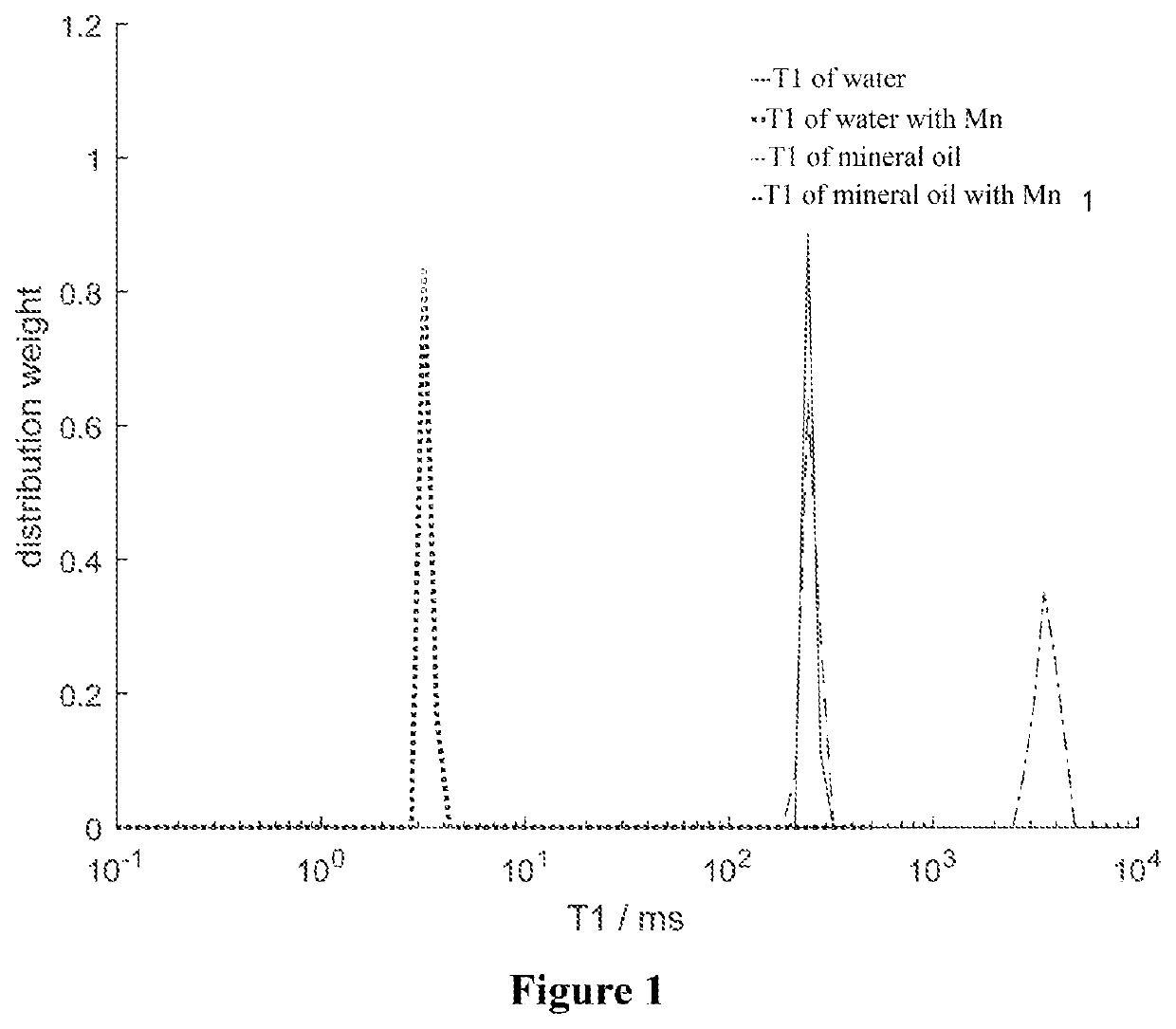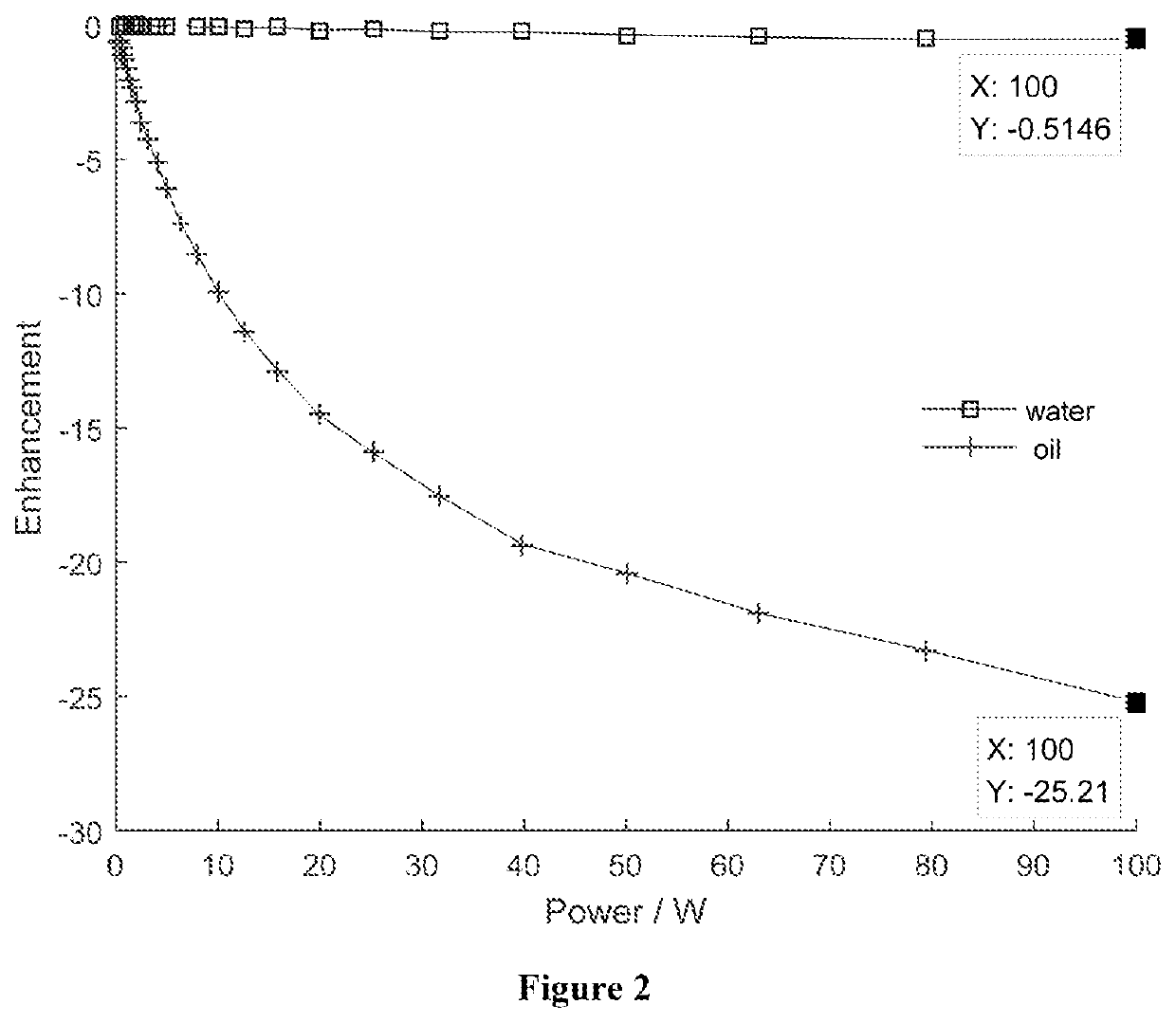Method for separating oil-water two-phase nmr signals by using dynamic nuclear polarization
a two-phase nmr signal and dynamic nuclear polarization technology, applied in the field of nuclear magnetic resonance applications, can solve the problems of limited sensitivity, limited application of high-field chemical shift spectroscopy, and relatively long time for low-field nmr testing, etc., to achieve efficient separation of oil-water two-phase nmr signals, short test time, and simple and easy operation
- Summary
- Abstract
- Description
- Claims
- Application Information
AI Technical Summary
Benefits of technology
Problems solved by technology
Method used
Image
Examples
example 1
[0023]1. T1 distributions of oil and water phases in the oil-water sample are tested at a 0.06 T static magnetic field.
[0024]2. MnCl2 is added to the oil-water sample and oscillated to be completely dissolved, and then rested for layering to obtain a mixed sample A. The concentration of MnCl2 in the mixed sample A is 10 mM. T1 distributions of oil and water phases in the mixed sample A are tested under a 0.06 T static magnetic field. The results of the two tests are shown in FIG. 1. From FIG. 1, it can be seen that before and after the addition of MnCl2, the relaxation time of the oil phase remains unchanged, and the relaxation of the water phase changes from 3.5 s to 3.2 ms.
[0025]3. TEMPO is added to the mixed sample A and mixed evenly to obtain a mixed sample B. The concentration of TEMPO in the mixed sample B is 10 mM. The single pulse sequence with DNP is used to test the enhancement effects of the oil and water phases in the mixed sample B. The results are shown in the FIG. 2. ...
example 2
[0026]1. MnCl2 and TEMPO are added to an oil-water sample and oscillated until MnCl2 is completely dissolved, and then the resulting solution is rested for layering to obtain a mixed sample. The concentrations of MnCl2 and TEMPO in the mixed sample are both 10 mM. The DNP single pulse sequence is used to test the DNP enhancement effect of the mixed sample, and the DNP enhancement effect of mineral oil tested by the DNP single pulse sequence is used as a reference. Results are shown in FIG. 3. From FIG. 3, it can be seen that the DNP enhancement of the mixed sample is similar to that of mineral oil, indicating that the signal of the water phase is suppressed, and the signal of the mixed sample after the enhancement is basically an NMR signal of the oil phase.
[0027]2. A CPMG sequence is used to test T2 distributions of oil and water phases in the mixed sample under a microwave power of 10 W, and the T2 distributions of the oil and water phases in the mixed sample without DNP enhanceme...
example 3
[0028]1. MnCl2 and TEMPO are added to an oil-water sample and oscillated until MnCl2 is completely dissolved, and then the resulting solution is rested for layering to obtain a mixed sample. The concentrations of MnCl2 and TEMPO in the mixed sample are both 10 mM.
[0029]2. Two pieces of sandstones with a permeability of 100 md and a porosity of 10.9% are taken and separately soaked in oil and water phases of the mixed sample for more than 12 hours. Then, the excess liquid on the surfaces of the two pieces of sandstones is wiped off and the sandstones are weighed. The weight of the sandstone soaked in the water phase increases from 1062 mg to 1118 mg, and the water content is 54 mg; the weight of the sandstone soaked in the oil phase increases from 715 mg to 747 mg, and the oil content is 32 mg.
[0030]3. A DNP single pulse sequence is used to test the DNP enhancement effects of the oil-containing sandstone and the oil-water-containing sandstone (oil-containing sandstone and water-conta...
PUM
 Login to View More
Login to View More Abstract
Description
Claims
Application Information
 Login to View More
Login to View More - R&D
- Intellectual Property
- Life Sciences
- Materials
- Tech Scout
- Unparalleled Data Quality
- Higher Quality Content
- 60% Fewer Hallucinations
Browse by: Latest US Patents, China's latest patents, Technical Efficacy Thesaurus, Application Domain, Technology Topic, Popular Technical Reports.
© 2025 PatSnap. All rights reserved.Legal|Privacy policy|Modern Slavery Act Transparency Statement|Sitemap|About US| Contact US: help@patsnap.com



